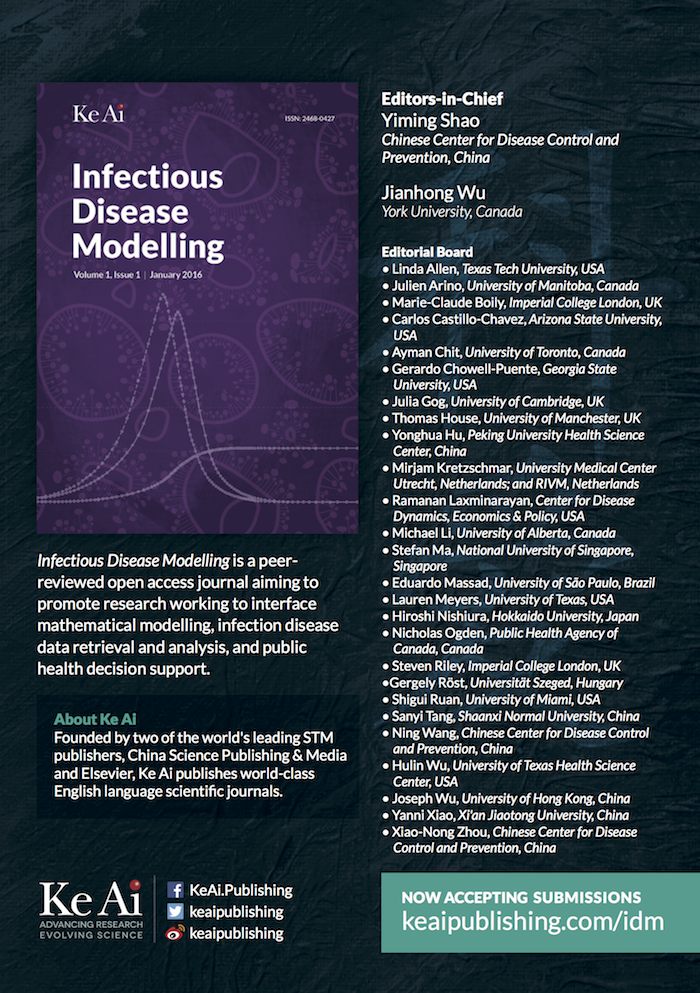IDM journal

International cooperation is a good thing in science; so it's nice to be able to announce a new journal Infectious Disease Modelling, which I'm helping to edit.

International cooperation is a good thing in science; so it's nice to be able to announce a new journal Infectious Disease Modelling, which I'm helping to edit.
I've recently had a New paper out in EPJ Data Science concerning preferential attachment (the 'rich get richer' effect) in social networks.
This is a relatively controversial area, and the aim of the paper was to try to be as systematic / objective as possible. The simplest way to explain our results, suggested by one of two pleasingly constructive reviewers, is that we estimate around 40% of social contacts arise due to the existence of existing social contacts (e.g. your friends introduce you to their friends) rather than from direct social activity. If this figure had been much larger, it would have created an epidemiological paradox - no infectious disease would be controllable.
The main innovation was to use a general finite-state-space Markov chain for the non-preferentially attached links, which generates a mechanistically interpretable phase-type distribution as a way to capture other sources of heterogeneity in contact numbers.
The journal's editor (quite a 'big name' with many followers) was also nice enough to promote the work on social media:
Testing preferential attachment in social network formation
http://t.co/2hXKf11dik
@EPJscience @TAH_Sci pic.twitter.com/X1hRXkAcFm
Together with Ed Hill and Frances Griffiths, I had a paper out in Proceedings B yesterday. There has been a bit of media interest in the paper (e.g. The Atlantic and the Daily Telegraph) but I assume that anyone reading this page is more interested in how the mathematics works. This is given in relatively full detail in the paper and Supplementary Material, so below I give a more informal account.
A ubiquitous problem in epidemiology is confounding, which is (very loosely speaking) where something else correlates with the actual causal mechanism for disease. In the current context, the issue is that there may be clusters of ill people on a social network due to spreading of the illness on the network, or it could be that people who share a risk factor tend to be linked on the network. So for depression (which we studied) it could be that people who drink heavily tend to be friends, but it is the drinking that causes the clusters of depression rather than the friendships.
There is a lot of interesting discussion of such questions in the context of social networks in a Special issue of Statistics in Medicine. Personally, I tend to think that while it is never possible to eliminate all forms of confounding in observational studies, these offer information that is not possible to obtain in experiments. Therefore the task for methodologists is to try to come up with methods that allow information to be reliably extracted from observational data. In the paper in question, we tried to reduce the possible role for confounding in the following way.

Figure 3 from the paper. D and N in the paper are equivalent to 1 and 0 in the discussion here respectively.
Suppose we have a Markov chain \(\mathbf{X}_t = (X^i_t)\), where \(X^i_t=1\) if individual \(i\in\{1,2,\ldots,N\}\) is ill at time \(t\) and \(X^i_t=0\) otherwise. If there is no social influence, then a standard modelling approach is to let \[\mathrm{Pr}(X^i_t=1) = f(\boldsymbol{\theta}_i) \mathrm{ ,}\] where \(\boldsymbol{\theta}_i\) is a vector of individual-level properties / behaviours for individual \(i\), and the function \(f\) is usually a logit transform on \(\boldsymbol{\beta}\cdot\boldsymbol{\theta}_i\). Here there is a lot of room for confounding if different elements of the vectors in \(\{\boldsymbol{\theta}_i\}_{i=1}^{N}\) are correlated with each other.
Now add the social network - a matrix with elements \[G_{i,j} = \begin{cases} 1 & \text{ if } j \text{ is } i \text{'s friend,} \\ 0 & \text{ otherwise.}\end{cases}\] Clustering in such a network is a tendency for friends to be in the same disease state - \(\mathrm{Pr}(X^i_t = X^j_t \vert G_{i,j}=1) \gt \mathrm{Pr}(X^i_t = X^j_t \vert G_{i,j}=0)\). The issue of confounding then becomes whether the links \(\{G_{i,j}\}_{i,j=1}^{N}\) (usually thought of as Bernoulli random variables like the disease states) are correlated with the \(\{\boldsymbol{\theta}_i\}_{i=1}^{N}\), or whether there is evidence for "spreading" of the disease as in Figure 3 of the paper.
Our way of answering this rests on the bit of stochastic process theory that says that distinct Markov chains can share the same stationary distribution, meaning that observations from this distribution alone cannot distinguish them, but may have different transition probabilities. A direct observation of transitions between disease states therefore allows us to consider determine model probabilities like \(\mathrm{Pr}(X^i_{t+1} = 1 \vert \mathbf{X}_t,\mathbf{G})\), and thereby distinguish between spreading over a network, and correlation of other properties / behaviours. The full details are given in the paper and supplement, but the basic idea that a lot of confounding is related to equivalent stationarity of stochastic processes behind the hypotheses to be considered, and could be mitigated by fitting to temporal observations (or other features that do distinguish those processes) is, I believe, a relatively general one.
I was a long-term participant in the Infectious Disease Dynamics programme at the Newton Institute.
This experience had a large effect on my thinking about the field, and allowed me to start new collaborations. One of the things that we did together is write the review paper Modeling infectious disease dynamics in the complex landscape of global health, which has just appeared in its final form. While the lead author, Hans Heesterbeek, did the really hard work of pulling everything together, the paper comes remarkably close to a consensus view of the most exciting directions in infectious disease modelling, and it's a good starting point for someone thinking about making contributions to this field.
Welcome to my new personal website. It's powered by Nikola, and contains information about my research and teaching.